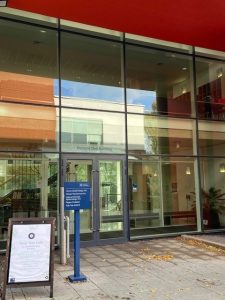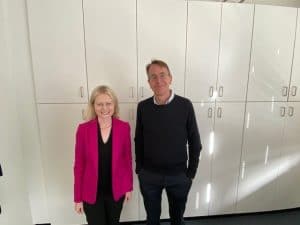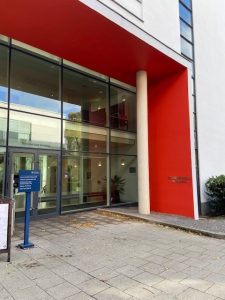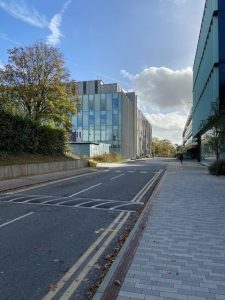27 October 2022
This week’s blog takes a fascinating look at the career of Professor Sir Rory Collins, Chief Executive of UK Biobank and the Head of the Nuffield Department of Population Health at Oxford University and the importance of the UK Biobank. To tell us more about his work and the ways the UK Biobank is helping to transform our future health and family life, Louisa Ghevaert was delighted to catch up with Professor Sir Rory Collins.

Images: Louisa Ghevaert CEO of Louisa Ghevaert Associates, Sir Rory Collins Chief Executive of UK Biobank and the Head of the Nuffield Department of Population Health at Oxford University
What lead you to study medicine and statistics?
I enjoyed maths and statistics and so I studied Medicine at St Thomas’s Hospital Medical School, London University from 1974-1980, adding on an additional year of study to obtain a BA Degree in Statistics at George Washington University from 1976-77 and then a further year at Oxford University from 1982-83.
What lead you to specialise in medical and epidemiology research?
Whilst I was studying statistics at George Washington University, I was introduced to a well known statistician who had set up a clinical trials unit with the National Institute of Health (NIH) and I was offered a paid job one day a week to work on a clinical trial. This got me used to working on randomised clinical trials.
After I had qualified in medicine and completed my medical house officer jobs, I decided I wanted to do more work on clinical trials. As such, I came to Oxford in 1981 to work with Professor Sir Richard Peto on clinical trials for heart attacks, for which there was then no cure, and I never left. This lead to me becoming co-director of the University of Oxford’s Clinical Trial Service Unit & Epidemiological Studies Unit (CTSU) in 1985. The following year, 1986, I was appointed Professor of Medicine and Epidemiology at Oxford, supported by the British Heart Foundation.
At first, I worked on an early small research study on lowering blood pressure to help people get through a heart attack. Then I undertook larger research studies on this and looked at other treatments, building on the network we had built for the first study. Our next study looked at an enzyme called Streptokinase to dissolve blood clots as we were at that time unclear whether blood clots were causing heart attacks or came afterwards due to abnormal heart pumping. We then tested the enzyme Streptokinase with aspirin in a large study of 17,000 patients, which showed that both treatments each reduced mortality by 20 percent and combined reduced mortality by 40-50 percent. This was how I got into research and moved into trials to prevent heart attacks and strokes. I then moved on to research into lowering cholesterol using statins which we found produced little in the way of side effects and were well tolerated and vitamins to prevent cholesterol from oxidising and becoming hazardous to protect against heart disease.
Why was the UK Biobank set up?
Our work on heart disease laid the foundations for the UK Biobank. In conducting a research study of 20,000 patients in the UK we obtained information from hospitals on patients with heart disease. We ran the research study centrally through clinics that we operated and staffed. This produced an efficient and centralised system, which was a very scalable approach. As our work progressed, we moved from hospitals to the NHS to get the data which we worked on centrally and this centralised model led on to the UK Biobank.
Our research studies looked into the association of risk factors for heart disease and the benefits of lowering cholesterol, lowering blood pressure and conducting large scale studies. Whilst we had looked at this through population studies on a long-term basis, no samples had been stored upon which long-term risk factors could be assessed. We therefore said that we needed to set up big studies and store blood samples so that we could conduct large scale long-term follow up on this. The Medical Research Council (MRC) and The Wellcome Trust agreed to fund this and after 2-3 years of discussions we decided to set up the UK Biobank.
The UK Biobank needed to be big and so we settled on a figure of 500,000 people. It was decided that participants should be of middle age, working on the basis that they were likely to develop diseases over the following 10-15 years but were young enough that we could still collect data before the onset of disease and then study the information generated by disease. A cohort of 500,000 people aged 40-69 were therefore invited to participate. At first, the UK Biobank operated through half a dozen groups around the country undertaking the study and collecting the data. However, it was a difficult model to operate as the staff did not obtain preferential access over the data and there was no academic return. After 2 years, the future of the project looked uncertain because it was not moving forward. I was then invited to apply for the position of Chief Executive at the UK Biobank to establish a new centralised model based on the large scale centralised research trials I had conducted. I took over in September 2005 and centralised everything, took away the financial risk of delivery and asked each group to take responsibility for one aspect of the whole study rather than each group taking responsibility for 80,000 participants. Under time pressures, we quickly carried out a pilot study in Manchester to show the model worked and this then opened the door to more funding and the main phase of recruitment from 2006-10. In doing do, the funders stipulated that the data UK Biobank generated must be available for all researchers on the same basis.
How is the UK Biobank helping to transform future health?
What is transformative about the UK Biobank is the way scientists can use the data, which is a combination of large scale data involving 500,000 participants and 15 years of follow-up. UK Biobank provides researchers with access to samples and detailed health histories at scale, with depth of characterisation and long-term monitoring as well as accessibility. This has resulted in researchers starting to use the data all around the world.
In 2015, the UK Biobank received funding to start genotyping participants and the results of this were released in 2016-17. This generated big interest from researchers overseas and bigger visibility for the UK Biobank. This made the data more valuable and companies started to approach the UK Biobank as we had measured 800,000 markers across the genome to help inform disease association, something which had not been done on this scale before. This led to further studies into Alzheimer’s, heart disease and obesity. It also led to the development of a concept known as polygenic risk assessments in 2016-17, which had previously been thought to be inaccurate. However, data from the UK Biobank changed this and showed polygenic risk scores are accurate; combining disease risk factors in genetic markers into a polygenic risk score to find 3-5 percent of people at risk of certain diseases like BRCA1 or BRCA2 breast or ovarian cancer. This opened up precision medicine initiatives and polygenic risk scores are now starting to be rolled out in cost effective US health initiatives to identify people at higher risk of heart disease, breast and colon rectal cancer and treat them earlier.
We are now looking at more ways to implement initiatives from the UK Biobank into practice to do more good and help transform our health. A recent pilot scheme has gone well adding a polygenic risk score assessment to the process when people consult their GP, adding genotype information to cholesterol and blood pressure measurements to help identify those most at risk of heart disease. As such, we are looking at implementing this more widely.
We have also seen the recent launch of Our Future Health Study in the UK, part-funded by government, industry and charities. This will involve collecting health and genetic data from five million adults in the UK to see how this data can be used within the NHS system and to see if people can be recruited to join drug trials using their genotype information and polygenic risk scores to find better ways to treat diseases.
We have also seen companies looking to access and enhance data at the UK Biobank and in return get an exclusive access period before the results are made accessible to all. For example, a consortium of companies led by Regeneron provided funding in 2018 to help exome sequence (reflecting the protein-coding portion of a genome) UK Biobank genetic data of the 500,000 participants more quickly for health researchers to use; representing an area where it is thought therapeutic targets will be found.
All of this demonstrates that the model adopted by the UK Biobank works. Essentially, it is a centralised model which is designed to help researchers access biomedical data and its accessibility and vision of scale represents a big shift in approach. The accessibility concept has achieved the obvious in helping researchers to access UK Biobank data. Importantly, it has also resulted in industry, government and charity funding to enhance the UK Biobank data. For example the UK government provided £20 million in funding for genotyping. As a result, there is a collaborative and progressive approach which we continue to foster at the UK Biobank. We are now carrying out imaging of the UK Biobank participants, taking magnetic imaging of the brain and heart and body, Dexer scans of the body and joints and ultrasound scans of the carotid artery. We have also received additional funding to bring back 60,000 of the 100,000 participants imaged to rescan them and compare the data.
Can the UK Biobank help inform family life?
We would like to recruit first degree relatives of participants (brothers, sisters, children and parents) to separate genetic from familial causes of disease. This will help inform our understanding and separate environmental and lifestyle from genetic risk factors. This will provide more information from which researchers can benefit and build upon work with family members that was undertaken to improve our understanding and treatment of Covid-19. Over time, this will produce more insights about our health and inform family life.
To what extent can the UK Biobank inform our individual fertility and genetic legacy?
UK Biobank also holds some information relevant to fertility and why people have more or less children in life. Data is available at UK Biobank on how many children people had, dates when female menstruation started and when people became sexually active. It also holds information about female ovarian function. As such, the opportunity is there for researchers to use the data in new and imaginative ways and to make suggestions and it is up to the UK Biobank to deliver it for the benefit of us all looking ahead.
For more information about genomics, fertility, family and wider law, policy and governance contact Louisa Ghevaert by email louisa@louisaghevaertassociates.co.uk or by telephone +44 (0)20 7965 8399.








